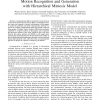67 search results - page 4 / 14 » Hierarchical Motion History Images for Recognizing Human Mot... |
ICIP
2003
IEEE
14 years 9 months ago
2003
IEEE
Complex human motion sequences (such as dances) are typically analyzed by segmenting them into shorter motion sequences, called gestures. However, this segmentation process is sub...
ICRA
2006
IEEE
14 years 1 months ago
2006
IEEE
— Communication skill is essential for social robots in various environments such as homes, offices, and hospitals, where the robots are expected to interact with humans. In thi...
JMM2
2007
13 years 7 months ago
2007
—This paper describes a new three-dimensional spatiotemporal template, namely the Volumetric Motion History Image (VMHI), for the purpose of human motion analysis. Irregularities...
ICIP
2000
IEEE
14 years 9 months ago
2000
IEEE
We describe a higher-orderspectralanalysis-basedapproach for detecting people by recognizing human motion such as walking or running. The periodic attribute of human motion lends ...
ICANN
2005
Springer
14 years 25 days ago
2005
Springer
Humans can recognize biological motion from strongly impoverished stimuli, like point-light displays. Although the neural mechanism underlying this robust perceptual process have n...

